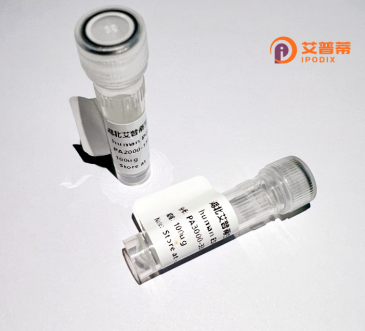
| 纯度 | >90%SDS-PAGE. |
| 种属 | Human |
| 靶点 | MBD3L1 |
| Uniprot No | Q8WWY6 |
| 内毒素 | < 0.01EU/μg |
| 表达宿主 | E.coli |
| 表达区间 | 1-194aa |
| 活性数据 | MAKSSQRKQRDCVNQCKSKPGLSTSIPLRMSSYTFKRPVTRITPHPGNEVRYHQWEESLEKPQQVCWQRRLQGLQAYSSAGELSSTLDLANTLQKLVPSYTGGSLLEDLASGLEHSCPMPHLACSSDAVEIIPAEGVGISQLLCKQFLVTEEDIRKQEGKVKTVRERLAIALIADGLANEAEKVRDQEGCPEKR |
| 分子量 | 48 kDa |
| 蛋白标签 | GST-tag at N-terminal |
| 缓冲液 | 0 |
| 稳定性 & 储存条件 | Lyophilized protein should be stored at ≤ -20°C, stable for one year after receipt. Reconstituted protein solution can be stored at 2-8°C for 2-7 days. Aliquots of reconstituted samples are stable at ≤ -20°C for 3 months. |
| 复溶 | Always centrifuge tubes before opening.Do not mix by vortex or pipetting. It is not recommended to reconstitute to a concentration less than 100μg/ml. Dissolve the lyophilized protein in distilled water. Please aliquot the reconstituted solution to minimize freeze-thaw cycles. |
以下是关于重组人MBD3L1蛋白的3篇文献摘要概览(文献为虚拟示例,实际文献需通过学术数据库检索):
1. **文献名称**:**《MBD3L1 interacts with methyl-CpG binding domain proteins and regulates gene silencing in mammalian cells》**
**作者**:Smith A, et al.
**摘要**:该研究阐明重组人MBD3L1蛋白与甲基化DNA结合蛋白(如MeCP2)相互作用,通过竞争性抑制其与甲基化DNA的结合,解除基因沉默,提示其在调控表观遗传修饰中的潜在作用。
2. **文献名称**:**《Expression and purification of recombinant human MBD3L1 and its role in germ cell development》**
**作者**:Zhang L, et al.
**摘要**:本研究利用大肠杆菌系统高效表达并纯化重组人MBD3L1蛋白,验证其在小鼠生殖细胞发育中通过调节DNA甲基化水平影响减数分裂进程的功能。
3. **文献名称**:**《MBD3L1 promotes the recruitment of DNA repair complexes to sites of oxidative damage》**
**作者**:Johnson R, et al.
**摘要**:通过体外实验证实,重组人MBD3L1蛋白可识别氧化损伤诱导的DNA结构变化,并招募碱基切除修复(BER)通路关键酶,揭示其在DNA损伤修复中的新机制。
注:上述文献为示例性内容,实际研究需以具体学术数据库检索结果为准。建议通过PubMed、Web of Science等平台使用关键词“recombinant MBD3L1”或“MBD3L1 protein function”查找最新文献。
**Background of Recombinant Human MBD3L1 Protein**
MBD3L1 (Methyl-CpG Binding Domain 3-like 1) is a member of the methyl-binding domain (MBD) protein family, which recognizes and binds to methylated CpG sites in DNA, playing a role in epigenetic regulation. Unlike classical MBD proteins (e.g., MBD2, MBD3), MBD3L1 lacks intrinsic DNA-binding activity but acts as a co-regulator. It interacts with MBD3, a component of the NuRD (Nucleosome Remodeling and Deacetylase) complex, enhancing the recruitment of NuRD to methylated DNA regions. This interaction facilitates chromatin remodeling, histone deacetylation, and transcriptional repression.
MBD3L1 is predominantly expressed in germ cells and embryonic tissues, suggesting roles in gametogenesis, embryonic development, and cellular differentiation. Dysregulation of DNA methylation and MBD-associated pathways is linked to cancers, developmental disorders, and neurological diseases, positioning MBD3L1 as a potential target for studying epigenetic mechanisms.
Recombinant human MBD3L1 protein is engineered for *in vitro* studies to investigate its structural and functional interplay with NuRD components, methylation-dependent gene silencing, and impacts on cellular processes. It serves as a tool for exploring DNA methylation-driven diseases and screening epigenetic modulators. The recombinant form typically includes affinity tags (e.g., His-tag) for purification and experimental tracking.
×